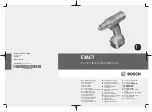
5
COLLEGAMENTO E FISSAGGIO ALIMENTAZIONE
Collegare il tamper antiapertura e antiasportazione
Collegare i cavi di alimentazione tra l’alimentatore PS515 e i moPS e -PS rispettando le polarità.
CARATTERISTICHE TECNICHE ALIMENTATORE CARICABATTERIA 1,5 A (Tipo A EN50131-6 ES1 IEC 62368-1)
I cavi impiegati devono rispondere alla norma IEC 60332-1-2 se di sezione 0,5 mm
2
o superiore, oppure alla norma IEC 60332-2-2 se di sezione inferiore a 0,5 mm
2
.
La batteria deve:
•
Essere di tipo VRLA (Valve Regulated Lead Acid)
•
Avere un involucro con classe di infiammabilità UL94V-1 o migliore
•
Essere conforme alle normative IEC 60896-21:2004, IEC 60896-22:2004
La sostituzione della batteria deve essere eseguita esclusivamente da personale qualificato.
MONTAGGIO IN BOX METALLICO
Per il montaggio a parete del box, fare riferimento alle istruzioni contenute nel box stesso.
Posizionare e fissare la scheda utilizzando le viti e i distanziali in dotazione.
•
A
- Cavi a corredo
•
B
- Portafascette
•
C
- Fusibile
•
D
- Cavo di terra con Faston a corredo
•
E
- Rete alimentazione
ATTENZIONE
Per l’installazione in centrali metalliche utilizzare i distanziali forniti in dotazione.
ATTENZIONE
Le uniche modalità di montaggio conformi alla normativa EN50131 sono quelle che prevedono la presenza dell’antiasportazione.
COLLEGAMENTO E FISSAGGIO ALIMENTAZIONE
Collegare il tamper antiapertura e antiasportazione.
Collegare i cavi di alimentazione tra l’alimentatore (+V -V) e i moPS e -PS rispettando le polarità.
Dopo aver effettuato i collegamenti applicare il coperchietto in plastica trasparente a protezione dei morsetti.
CARATTERISTICHE TECNICHE ALIMENTATORE CARICABATTERIA 3,4 A (Tipo A EN50131-6 ES1 IEC 62368-1)
2
3
6
4
2
4
5
7
This document contains only essential information about the product. Refer to the manuals of the MP3000 panel for more information.
GENERAL DESCRIPTION
The SA3000 supplementary bus power supply is a board which, when housed in the plastic box or metal box. It can be purchased separately to increase the availabili
-
ty of current and the number of devices connected to the MP3000 control panel.
The board has 2 output buses and an additional power output, which can be galvanically separated from the control panel power supply by means of the jumper
JP2
.
The power supply unit is connected via BUS to the control panel from which it is supervised.
It is possible to connect 7Ah batteries in a plastic box or 18Ah batteries in a metal box; the
JP3
jumper allows the charging current to be selected for 7Ah or 18Ah
batteries.
ELECTRICAL LINE CONNECTION PROCEDURE
A suitable isolating device, such as a two-pole thermomagnetic circuit breaker (
B
), not exceeding 10 A, must be installed to protect the mains supply (
A
).
CONTROL PANEL BUS CONNECTION
The supplementary power module can be connected on the bus in cascade, in either star or mixed mode (
BUS IN
). The position along the bus is irrelevant. The total
length of the bus must not exceed 500 metres (cable cross-section area 2x0.75 mm2 power + 2x0.22 mm2 data).
NOTE
: The maximum distance depends on the cross-section of the bus power cable (
+
and
-
) and the power consumption of the board.
The max. power consumption of the power supply unit must also be taken into account when calculating the overall power consumption of the systeme.
OUTPUT BUS CONNECTION
Connect the bus devices to be supplied to the output buses (
BUS OUT 1
and
BUS OUT 2
). The presence of two electrically separate buses makes it possible to
increase the number of devices managed by the control panel and the overall length of the routes. The total length of all bus stretches must not exceed 500 m.
IMPORTANT
Never exceed the current or voltage values supported by the outputs (see technical specifications of the devices to be connected).
POWER MODULE ACQUISITION
Acquisition is carried out in manual mode using the peripheral device search function of the control panel. See the MP3000 control panel programming manual for
more details.
INSTALLATION IN PLASTIC BOX
Refer to the instructions contained in the box itself for wall mounting of the box.
Position and secure the board using the screws provided.
•
A
- Cables included
•
B
- Short cable tie included for compulsory power wire fixing
•
C
- Power supply network
•
D
- Long cable tie supplied for battery fixing. The cable ties passes through the holes for routing the cables.
Compulsory use for EN50131 Grade 3 certification
IMPORTANT
The only installation methods that comply with EN50131 are those that require the presence of the tamper protection.
POWER CONNECTION AND FIXING
Connect the opening and removal tamper protection
Connect the power supply cables between the PS515 power supply and the +PS and -PS terminals respecting the polarities.
TECHNICAL DATA POWER SUPPLY 1.5 A (Type A EN50131-6 ES1 IEC 62368-1)
Wires with cross-section area of 0.5 mm2 or larger must comply with IEC 60332-1-2; wires with cross-section area smaller than 0.5 mm2 must comply with IEC
60332-2-2.
The battery must:
•
Be of the VRLA (Valve Regulated Lead Acid) type
•
Have an enclosure with flammability class UL94V-1 or better
•
Comply with IEC 60896-21:2004, IEC 60896-22:2004 standards
The battery must be replaced by qualified personnel only.
INSTALLATION IN METAL BOX
Refer to the instructions contained in the box itself for wall mounting of the box.
Position and secure the board using the screws and spacers provided.
•
A
- Supplied cables
•
B
- Cable tie holder
•
C
- Fuse
•
D
- Earth cable with Faston supplied
•
E
- Power supply network
IMPORTANT
Use the spacers supplied for installation in metal control panels.
1
3
2
3
6
4


























